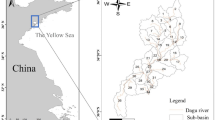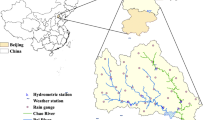Abstract
In order to implement best environmental management practices in agricultural watershed, it is necessary to evaluate non point source pollution loads and identify critical watershed pollution sources, which are regional management priority missions. Nutrient related non point source pollutant inputs can increase primary production and intensify water eutrophication. Not all watershed areas are critical and responsible for high amount nutrient pollution losses. Implementation of watershed environmental prevention is required to assess pollution yields. Further more, identification of these critical areas is essential for the effective and efficient implementation of watershed best environmental management. In this study, a geographic information system based Soil and Water Assessment Tool was applied in Bahe River watershed, a part of the Yangtze River basin. Land use, soil series texture and daily rainfall data for a 10-year period (1996–2005) was used in this study. The calibrated model system was verified to estimate average annual Organic Nitrogen and Organic Phosphorus yields in these 10 years. The estimated results were also tested and optimized by statistical software. Based on 10-year average yearly Organic Nitrogen yield and Organic Phosphorus losses, critical sub-watersheds were identified. The five sub-watersheds in the north part of watershed were under more intensive pollution yield, west group sub-watersheds contributed to moderate losses, whereas other sub-watersheds fell under slight loading classes. The research outputs developed a basis for an effective watershed environmental management plan. The study revealed that the Soil and Water Assessment Tool could be applied successfully for identifying critical sub-watersheds for watershed best environmental management purposes.







Similar content being viewed by others
References
Arnold, J. G., Srinivasan, R., & Muttiah, R. S. (1998). Large area hydrologic modeling and assessment. Part I: Model development. Journal of the American Water Resources Association, 34, 73–89.
Banaszuk, P., Wysocka Czubaszek, A., & Kondratiuk, P. (2005). Spatial and temporal patterns of groundwater chemistry in the river riparian zone. Agriculture, Ecosystems & Environment, 107, 167–179.
Bhuyan, S., Kalita, P. K., & Janssen, K. A. (2002). Soil loss predictions with three erosion simulation models. Environmental Modelling Software, 17, 135–144.
Bouldin, J. L., Farris, J. L., & Moore, M. T. (2004). Vegetative and structural characteristics of agricultural drainages in the Mississippi Delta landscapes. Environmental Pollution, 132, 403–411.
Bouraoui, F., Benabdallah, S., & Jrad, A. (2005). Application of the SWAT model on the Medjerda river basin (Tunisia). Physics and Chemistry of the Earth, 30, 497–507.
Bryant, R. B., Gburek, W. J., & Veith, T. L. (2006). Perspectives on the potential for hydropedology to improve watershed modeling of phosphorus loss. Geoderma, 131, 299–307.
Caroline H. (2006). Collaborative environmental planning in river management: An application of multicriteria decision analysis in the White River Watershed in Vermont, Journal of Environmental Management, DOI 10.1016/j.jenvman.07.013.
Chaplot, V. (2007). Water and soil resources response to rising levels of atmospheric CO2 concentration and to changes in precipitation and air temperature. Journal of Hydrology, 337, 159–171.
Cheng, H., Ouyang, W., & Hao, F. (2007). The non-point source pollution in livestock-breeding areas of the Heihe Riverbasin in Yellow River. Journal of Stochastic Environmental Research & Risk Assessment, 21, 213–221.
Di Luzio, M., & Arnold, J. G. (2004). Formulation of a hybrid calibration approach for a physically based distributed model with NEXRAD data input. Journal of Hydrology, 298, 136–154.
Hassen, M., Fekadu, Y., & Gete, Z. (2004). Validation of agricultural non-point source (AGNPS) pollution model in Kori watershed, South Wollo, Ethiopia. International Journal of Applied Earth Observation and Geoinformation, 6, 97–109.
Jeon, J. H. (2007). Development of the HSPF-Paddy model to estimate watershed pollutant loads in paddy farming regions, Agricultural Water Management, DOI 10.1016/j.agwat. 02.006.
Kang, M. S., Park, S. W., & Lee, J. J. (2006). Applying SWAT for TMDL programs to a small watershed containing rice paddy fields. Agricultural Water Management, 79, 72–92.
Lenhart, T., Fohrer, N., & Frede, H. G. (2003). Effects of land use changes on the nutrient balance in mesoscale catchments. Physics and Chemistry of the Earth, 28, 1301–1309.
Malhi, S. S., Lemke, R., & Wang, Z. H. (2006). Tillage, nitrogen and crop residue effects on crop yield, nutrient uptake, soil quality, and greenhouse gas emissions. Soil and Tillage Research, 90, 171–183.
Miller, S. N., Semmens, D. J., & Goodrich, D. C. (2007). The automated geospatial watershed assessment tool. Environmental Modelling & Software, 22, 365–377.
Muleta, M. K., & Nicklow, J. W. (2005). Sensitivity and uncertainty analysis coupled with automatic calibration for a distributed watershed model. Journal of Hydrology, 306, 127–145.
Neitsch, S. L., Arnold, J. G., & Kiniry, J. R. (2002). Soil and Water Assessment Tool theoretical document, VERSION 2000. Grassland, Soil and Water Research Laboratory, Agricultural Research Service, Texas.
Ning, S., Chang, N., & Jeng, K. (2006). Soil erosion and non-point source pollution impacts assessment with the aid of multi-temporal remote sensing images. Journal of Environmental Management, 79, 88–101.
Ning, S., & Chang, N. (2006). Watershed-based point sources permitting strategy and dynamic permit-trading analysis. Journal of Environmental Management, DOI 10.1016/j.jenvman.06.014.
Paliwal, R., Sharma, P., & Kansal, A. (2007). Water quality modelling of the river Yamuna (India) using QUAL2E-UNCAS. Journal of Environmental Management, 83, 131–144.
Petra, J., & Bohumír, J., (2005). Water quality in rural areas of the Czech Republic: Key study Slapanka River catchment. Limnologica - Ecology and Management of Inland Waters, 35, 160–168.
Plusa, M., La Jeunesseb, I., & Bouraoui, F. (2006). Modelling water discharges and nitrogen inputs into a Mediterranean lagoon impact on the primary production. Ecological Modelling, 193, 69–89.
Richards, C. (2007). Assessment of a turfgrass sod best management practice on water quality in a suburban watershed. Journal of Environmental Management, DOI 10.1016/j.jenvman.2006.12.039.
Schlüter, M., Savitsky, A. G., & McKinney, D. C. (2005). Optimizing long-term water allocation in the Amudarya River delta: a water management model for ecological impact assessment. Environmental Modelling Software, 20, 529–545.
Schob, A., Schmidt, J., & Tenholtern, R. (2006). Derivation of site-related measures to minimise soil erosion on the watershed scale in the Saxonian loess belt using the model EROSION 3D. CATENA, 68, 153–160.
Shrestha, S., & Kazama, F. (2007). Assessment of surface water quality using multivariate statistical techniques: A case study of the Fuji river basin, Japan. Environmental Modelling & Software, 22, 464–475.
Tolsona, B. A., & Shoemaker, C. A. (2007). Cannonsville Reservoir Watershed SWAT 2000 model development, calibration and validation. Journal of Hydrology, 337, 68–86.
Tong, S. T. Y., & Chen, W. (2002). Modeling the relationship between land use and surface water quality. Journal of Environmental Management, 66, 377–393.
Zhang, X., Zhang, Y., & Wen, A. (2003). Assessment of soil losses on cultivated land by using the 137Cs technique in the Upper Yangtze River Basin of China. Soil and Tillage Research, 69, 99–106.
Acknowledgements
The authors would like to gratefully thank the Chinese National Nature Science Committee for the fund for the research of NPS pollutions (Fund Number 40471127). We also appreciate the efforts of local helpers who assisted the field investigations and the local governments for providing data.
Author information
Authors and Affiliations
Corresponding author
Rights and permissions
About this article
Cite this article
Ouyang, W., Hao, FH. & Wang, Xl. Regional Non point Source Organic Pollution Modeling and Critical Area Identification for Watershed Best Environmental Management. Water Air Soil Pollut 187, 251–261 (2008). https://doi.org/10.1007/s11270-007-9513-y
Received:
Accepted:
Published:
Issue Date:
DOI: https://doi.org/10.1007/s11270-007-9513-y




